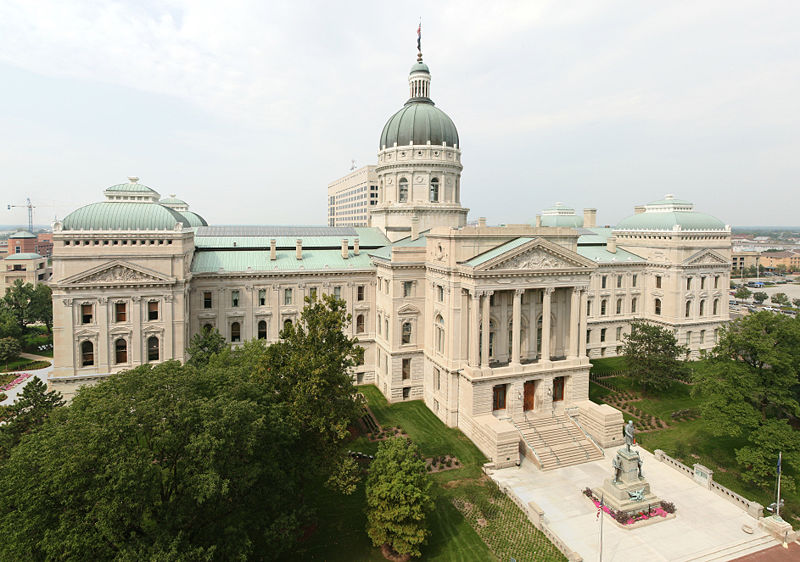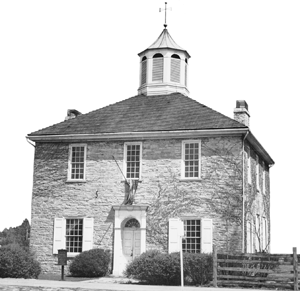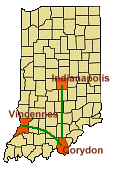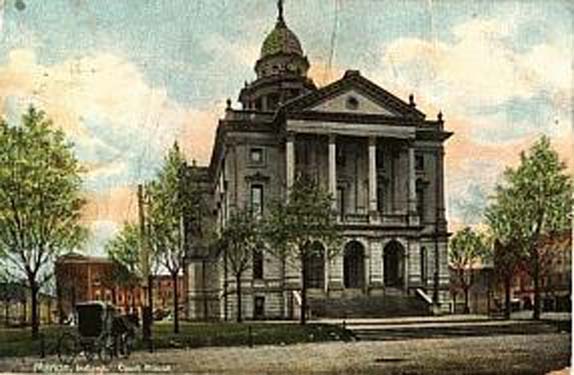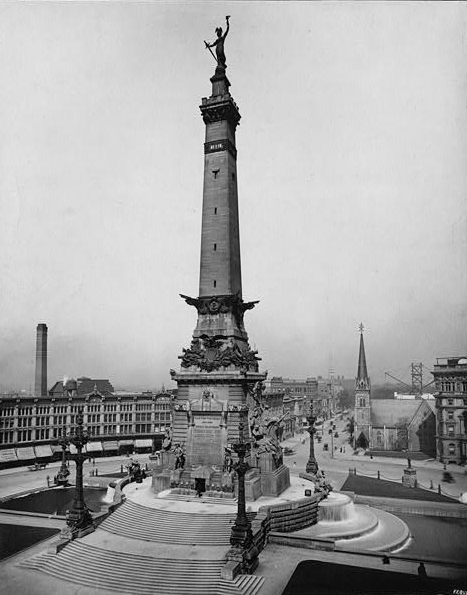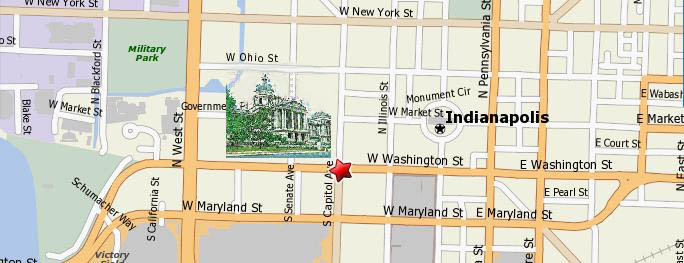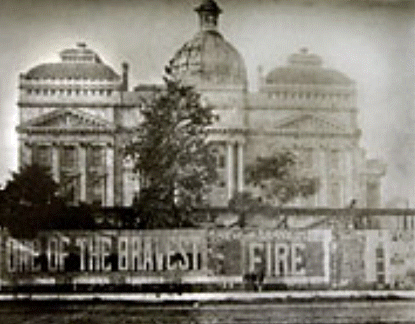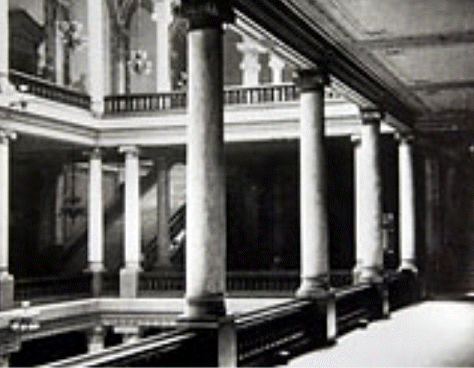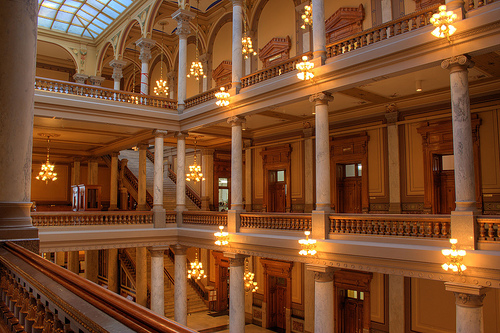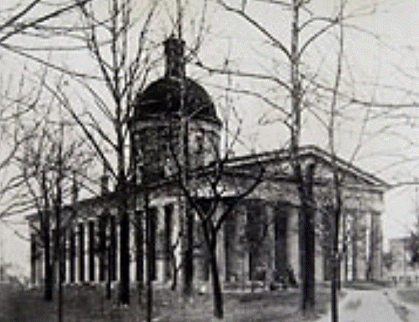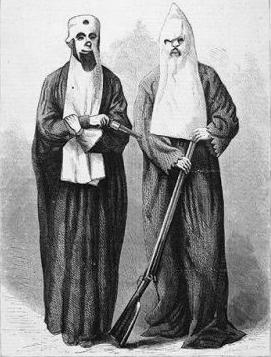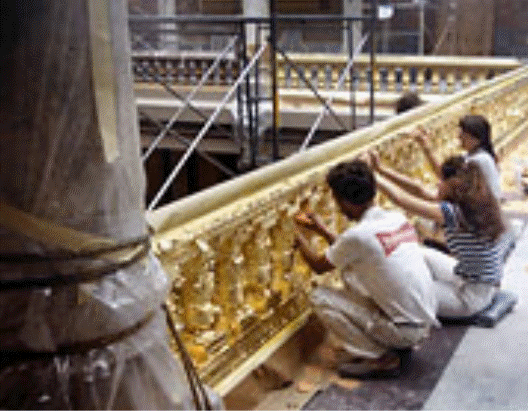|
|
Indiana Statehouse
The Indiana Statehouse (or State House) is the state capitol building of the U.S. state of Indiana. The Indiana Statehouse houses the Indiana General Assembly, the Governor of Indiana, the Supreme Court of Indiana, and other state officials. The Indiana Statehouse is located at 200 West Washington Street. Built in 1888, it is the fifth building to house the state government.
History First
Statehouse Second Statehouse
Third Statehouse
The first seat of government for the Indiana Territory was located in Vincennes (1800-1813); the government building, believed to have been built in 1800, is now a State Historic Site. Vincennes is the oldest town in present-day Indiana. The second statehouse, located in Corydon, Indiana, is still standing and is maintained as a state historic site. The third building to house the seat of government was the old Marion County courthouse. While the State House location had remained fixed since 1835, the original building no longer stands as it was torn down and replaced in the early twentieth century. The fourth building replaced it in 1888; a structure inspired by the Parthenon and is the State House in use today. However almost one hundred years later the building was condemned in 1877 because of structural defects and razed; extensively renovated, so the current statehouse could be built on its location. In 1800, the Indiana Territory was formed and Vincennes, nestled along the Wabash River, became its capitol. The Indiana Territory was carved out of the Northwest Territory pursuant to an act of Congress, approved May 7, 1800, entitled "An act to divide the territory of the United States northwest of the Ohio into two separate governments." In this act it was provided: " That from and after the fourth day of July next all that part of the territory of the United States northwest of the Ohio River which lies to the westward of a line beginning at the Ohio, opposite to the mouth of Kentucky River, and running thence to Fort Recovery, and thence north until it shall intersect the territorial line between the United States and Canada, shall, for the purposes of temporary government, constitute a separate Territory, and be called the Indiana Territory." The Indiana Territory then embraced within its boundaries most of the territory now included in the State of Indiana, all of Illinois and Wisconsin, the western half of Michigan and a part of Minnesota, and was divided into three counties.
Of these St. Clair County, named after General Arthur St. Clair, the first governor of the Northwest Territory, had been originally formed pursuant to a proclamation of the governor on April 27, 1790, and included all of what is now the State of Illinois south of the Illinois River and west of a line drawn from Fort Massac to the mouth of Mackinaw Creek. Knox County, named in honor of General Henry Knox, had been formed pursuant to a proclamation by Winthrop Sargent, the secretary of the Northwest Territory, acting in the place of the governor, on June 20,1790. Originally it embraced all, or nearly all, of what is now included in the States of Indiana and Michigan. William Henry Harrison became its first governor and then went on to become the United States ninth president. Grouseland, the home he built and the first brick home in the territory, still stands today and is open for tours daily. Governor William Henry Harrison and his three coworkers, the judges, were William Clarke, Henry Vanderburgh and John Griffin. John Gibson was Secretary of the territory and acting-governor on various occasions. Harrison himself did not arrive at Vincennes until January of 1801 and prior to that Gibson appointed a number of minor officials and attended to the necessary administrative matters. One of Harrison's first acts was to convene his judges and proceed to adopt and publish laws for the territory, the resulting being a code of seven laws and three resolutions. These, chiefly, dealt with the levying of taxes, the practice of attorneys and of courts, the establishment of courts, the compensation of officers and the establishment of ferries The territorial judges at Vincennes began the first session of the general court, on March 3, 1801, and the first grand jury was empanelled with nineteen members. The site is located at 1 West Harrison Street and considered the oldest major government building in the Midwest; it is now used to interpret early government in the Territory.
On November 4, 1816 at 9:00 in the morning the first session of the Indiana General Assembly convenes, fulfilling the final requirement for admission to the Union. On Dec. 11, Indiana is officially granted statehood status. Corydon, the territorial seat of government, becomes the first Indiana capital and the seat of government was moved from Vincennes to Corydon.
Corydon was the state capitol from 1816-1824 and is considered to hold the FIRST CAPITOL BUILDING for Indiana.
Corydon is a town located in Harrison County, Indiana. Corydon was a logical choice at the time because settlers and supplies heading west arrived via the Ohio River a short distance away. Indiana became a state on December 11, 1816, and Corydon remained the seat of government. The first capitol building was a humble, two-story limestone building constructed in 1813 to house the legislature of the Indiana Territory. The building was constructed by a firm owned by Dennis Pennington, a leader in the early territorial legislature. Construction cost $1,500, paid for by the citizens of Harrison County, and was completed in three years. It measured forty-square-feet with walls two-feet-thick and ten-foot ceilings. The building was made of limestone cut from a nearby quarry and at the time of its completion, was one of the largest buildings in the state. The capitol contained three rooms and quickly became too small for the state government, who had to erect additional office buildings across the street for the state's administration. The lower floor of the statehouse was used by the Indiana House of Representatives. The upper floor was split into two rooms, one for the Indiana State Senate and another for the Indiana Supreme Court, with a narrow hall between them. Isaac Blackford was appointed to the court in 1817 and became the second Chief Justice of the court. Blackford was the longest serving judge in the history of court, serving more than thirty-five years. He recorded all of the court's early decisions in a multi-volume work entitled Blackford's Reports that served many years as a foundational text on the interpretation of state laws. As more roads were built and settlement moved northward, a centrally located seat of government was needed. In January 1821 the site where Indianapolis is now located was designated as such, and the city was created. The building was abandoned as the capitol in 1824 and was given to Harrison County to use as a courthouse. The old capitol building is still persevered and is now a state historic site
When the state government relocated to Indianapolis in December 1824, the government operated out of the Marion County Courthouse.
The courthouse had been constructed with state funds in 1822 after Indianapolis was chosen as the site for the new capitol. The courthouse served as the state capitol building for twelve years. At the time Indianapolis was in the wilds, nearly sixty miles (100 km) from the nearest settlement of significance making large scale construction impractical. It stood on the south end of the present State House grounds, facing Washington Street. While not grand, the Marion County Courthouse of the 1820s was suitably formal - a brick, cubical "coffee grinder" building with Palladian windows, likely inspired by earlier such courthouses in New England. The State of Indiana followed with its first permanent government building in the new capital. The statehouse was built of blue limestone, two stories high. The governor and the supreme court occupied the lower floor, and the legislature and the occupied the upper floor, with each house in its own wing. The building saw many great events in its history, including a bier for Abraham Lincoln. The court has heard various cases that have had a major impact on Indiana, and others cases that have set nationwide precedents. The first of these cases was Polly v. Lasselle, an 1820 case that resulted in all slaves in Indiana being freed.
Polly v.
Lasselle (Knox Co. Court Record #2490 [90-146-32] and #2890-2) was an
1820 state supreme court Case in the US state of Indiana where
abolitionists attempted to a free a slave from her master. The case
resulted in the court ordering all slaves held within Indiana to be freed. In the 1823 case about the Fall Creek Massacre. The Fall Creek Massacre was a slaughter of Seneca Indians in 1824 by white settlers in Madison County, Indiana . Five white men committed the crimes. Four were captured and charged with murder. All four were convicted and sentenced to death by hanging . It was the first documented case in which white Americans were convicted, sentenced to capital punishment, and executed for the murder of Native Americans under the law in the United States. State records and the state treasury physically moved to Indianapolis in October 1824. The move to Indianapolis was an arduous task. When the move took place it was an eleven day journey by horseback and required four four-horse wagons from Corydon to the new capitol. To complicate matters, no road existed and a path for the wagons had to be cut through the dense forests during the winter trip as the long caravan moved north. The roads were such that only two and one-half miles were made the first day. The roads were often covered with water so deep that they were impassable. Delays were caused by the felling of trees to make roads for the wagons. The government of the state was officially transferred to Indianapolis on January 10, 1825, when the legislature convened for its regular session. The caravan was necessarily large; it contained the state treasury, state library, state records, and the furniture of the General Assembly, Supreme Court, and Execute Offices, along with a whole host of other implements to aid the caravan on its long journey. Colonel Samuel Merrill, the state treasurer, was authorized by the General Assembly to oversee the move. Ultimately, it took over a month to relocate the government to the capitol. The first session of the General Assembly convened there in January 1825. Until 1835 Indiana had no formal building in which to conduct the business of state. State offices were scattered across the new city in a host of houses and storefronts, and sessions of the General Assembly were held at the Marion County Courthouse. Over the years the building's limestone foundation began to fail, and many feared a general structural collapse of the building. Either due to poor craftsmanship, maintenance, or design, the stucco-covered brick exterior walls and metal roof did not withstand Hoosier weather conditions. In 1867, the ceiling of the House Chamber had collapsed. The damage was repaired, but dilapidated and unsafe conditions in the building led to the 1873 creation of a New State House Committee to study the issue. The Marion County Courthouse was a bombastic French Second Empire building of brick and limestone, encrusted with sculpture. In the decades of its service, prior to demolition in 1962, the courthouse was an important downtown landmark. Planning and creation of a monument to honor Indiana's Civil War veterans signaled a dramatic change toward monumental civic architecture. The Indiana General Assembly appointed a committee to plan the State Soldiers and Sailors Monument in 1887. The c. 285-feet-tall monument transformed the heart of the city into a grand commemorative space, when it was completed in 1901.
In 1877, a Board of State House Commissioners was created to complete construction of a new Statehouse building at a cost not to exceed $2,000,000. In 1869, a bitterly divided General Assembly approves the proposed 15th Amendment to the U.S. Constitution, which states that the right to vote could not be abridged due to race, color or previous condition of servitude. During the regular session, Democrats resign en masse to prevent a quorum. All 37 are re-elected before the special session, but when it is time to vote on the amendment, they resign a second time. Republicans proceed to ratify the amendment by themselves. Despite the dubious legality of voting without a quorum, Indiana's black males become eligible to vote. Fourth statehouse / Current Statehouse
With Indiana's rapid increase in population during the middle of the nineteenth century, the state's government increased in size and caused the previous capitol building to become crowded. In 1865, a state office building had to be constructed to house some of the burgeoning government, and the Supreme Court and several bureaus were moved into the new building. The previous statehouse had also become dilapidated with age and was eventually condemned in 1877. Without a capitol building to house the government's offices, the administration of Governor James D. Williams proposed the construction of the current state capitol building. The plan was approved by the Indiana General Assembly in the legislative session of 1878. Once the third state capitol building had been razed, the new building was constructed on the same site. Two million dollars (USD) were appropriated for construction of the new building, and it was completed in 1888. Governor Williams, who was famed for his frugality, was able to complete the project for $1.8 million and returned the extra $200,000 to the general fund. A team of commissioners, including former Civil War general and civil engineer Thomas A. Morris, planned and oversaw the project. The structure was designed by Edwin May, an Indianapolis architect. Not wanting to repeat the mistakes made in the construction of the previous statehouse, the legislature had instructed that the new capitol be built on a solid foundation, so that it would last for many decades. Detroit architect Elijah Myers files a lawsuit in 1879, claiming May had stolen elements of his design. (He later loses in federal court.) Construction began in 1880 and the cornerstone was laid.
The cornerstone, a ten-ton block of limestone from Spencer, Indiana, was laid during a formal ceremony on September 28, 1880. It was simply inscribed, "A.D. 1880." Edwin May died in February 1880, and his draftsman, Adolph Scherrer, was named to succeed him as supervising architect. The interior was modeled in the Italian Renaissance style. Wherever possible, materials native to Indiana were used. Doors were made of Indiana oak, and Indiana limestone was used throughout the structure. The building's cornerstone is a ten ton block of limestone quarried in Spencer, Indiana. The central dome was completed in 1883. The exterior of the building was completed on July 3, 1886, and the focus of construction moved to the interior. The General Assembly held its first session in the new State House on January 6, 1887. Although work was still underway, the House and Senate Chambers, rotunda, corridors and atriums were complete. The Rotunda will comfortably accommodate 170 guests.
The General Assembly conducts its first session January 6 1887 in the new Statehouse. The General Assembly accomplishes little in this session because of a partisan deadlock over who would replace Lt. Gov. Mahlon D. Manson, who resigned the previous year. Republican Robert S. Robertson was elected to replace him, but the Democrat-controlled Senate chooses Alonzo Greene Smith as presiding member instead. Construction work continued until October 1888, when grading and seeding of the grounds were completed. The entire building is veneered in Indiana limestone as the footings for the outer and inner walls of the basement are of Blue Limestone from St. Paul, Greensburg, and North Vernon, Indiana. Outer walls are of Oolitic Limestone from Monroe, Lawrence and Owen Counties. The north and south faces are similar, each with Corinthian porticoes flanked by pavilions with low domes. Scherrer's bold, plastic design for the various façades included a rusticated base, pedimented window hoods, and pediments on each corner pavilion face, richly carved with foliate work. The south elevation fronted on the National Road and has more ornamentation. The sculptural program atop the portico is The Westward Journey. On the left side of the cornice ledge, Native Americans are forced west, while Euro-American pioneers enter from the east. Eight large columns of polished Jonesboro Granite from Maine support the dome. Columns and pilasters for the second, third and fourth stories are of Sutherland Falls Marble from the East. Chandeliers, brackets and doorknobs are made of brass, and the interior finish was completed in Indiana oak, maple and walnut, with white oak used for the office finishes.
Of the court hearing various cases that have had a major impact on Indiana, and others cases that have set nationwide precedents, the case of In Falkenburg v. Jones, an 1889 case, Indiana became the first state to established the right for a defendant to obtain court records free of charge. In the 1909 case of Woessner v. Bullick, the principle was established that the court could invalidate a governor's veto if proper veto procedures were not followed. The state was among the first to adopt an Exclusionary rule. Established in the case of Callendar v. State, held in 1917, by preventing illegally obtained evidence from be submitted in court. William v. Smith, a 1921 case, overturned the Indiana's eugenics laws, the first of their kind in the nation. The building appears to have remained largely unchanged until 1904, when the first major renovation was begun. At that time, the wallpainting designs were redone in oil to remedy darkening of the original watercolors used on the walls. Much of the woodwork was refinished, and in 1906 the gilding was renewed on the lantern of the dome. Major remodeling was done between 1917 and 1920. In a project supervised by architect Herbert Foltz, additional office space was provided by conversion of the stables on the first floor into finished space. No longer needing the carriage ramp at the base of the north steps, access to the first floor was improved by the addition of interior stairways and exterior doors. Electric chandeliers replaced all of the original combination gas/electric fixtures on the second floor, in the Governor's Office and in the Senate and House Chambers. The greatest change in the appearance of the building was made in 1917-1920 by repainting the original wallpainting in shades of green, buff and yellow highlighted with red and blue. These new designs were later painted out in a 1928-1929 renovation, the last improvement until after World War II. The outside of the building received its first cleaning in 1931 when steam was used to remove a black coat of soot presumably caused by the widespread burning of coal and the advent of the automobile. By the post-World War II era Victorian architecture had plummeted to its lowest popularity. Also, a great deal of maintenance had been postponed since the Depression in the 1930s. In a 1946-1948 remodeling project, the electrical wiring was updated, aluminum and glass entry doors were installed at all second (main) floor entrances, and the original monumental oak doors on the north and east sides of the building were removed. Original cast iron lampposts were removed from limestone bases on the retaining wall around the grounds and florescent fixtures replaced the 1919 sconces on the east portico. Corridor walls were painted a neutral pastel color. The most vivid change in the character of the building, however, was the remodeling of the House and Senate Chambers for the first time since the original construction. Originally, each chamber took up a very large area: its current space plus several feet around it, reaching all the way to the outer walls. In 1947-1948, to accommodate senators and representatives, offices were built within the original chambers. Now behind each chamber are four floors of small offices. The inner chambers were then decorated with paneled wainscoting surmounted by murals. The mural completed in the House Chamber remains today; the Senate murals were removed in a subsequent remodeling. The corridors were painted in a turquoise blue / sunflower yellow scheme. In 1964, the exterior of the building was sandblasted, the dome was painted with gold epoxy, the north parking lot was enlarged, fifty spotlights were installed on the grounds and the Governor's Office was remodeled. In 1966, the House Chamber was again remodeled. The Senate followed suit with additional remodeling in both 1974 and 1986. In 1968, a number of original corridor chandeliers, which had been cleaned and rewired in 1958, were removed and replaced with modern fixtures. The sconce fixtures on the spandrels of the atriums on either side of the rotunda were removed at the same time. The two courtyards with skylights north and south of the rotunda are lined with three story arcades of marble columns. Original oak doorways and marble paneling were cleaned as part of the restoration. The wall and ceiling stencil work was replicated as were the ornate brass chandeliers. Gold leaf was reapplied to surfaces long rendered dull by constant use. The rotunda is one of the city's magnificent historic spaces. In the wake of the American Bicentennial in 1976 tastes once again began to change. In 1978, the dome was given its first new copper cladding as a part of the building's first major roofing replacement. In 1984, the art glass dome of the rotunda was cleaned and repaired. The building was also wired for electricity, even though Indianapolis did not yet have an electrical power grid. In 1887, the new capitol was sufficiently finished for the first legislative session to be held there. Construction ultimately took eight years, and the building was finally completed in October 1888. With the pinnacle of the building reaching 256 ft (78 m) high, it was the second tallest building in the state at the time of its completion. The Indiana State Capitol, the Statehouse, has been the seat of Indiana's government since 1887 and is perhaps the grandest 19th-century Neo-Classical Revival building in Indiana. A hole was bored in the cornerstone, and a time capsule was placed inside containing forty-two items. The items included annual reports from all the government agencies, a Bible, samples of several varieties of crops grown in Indiana, several new coins, local maps and newspapers, a book on the history of Indianapolis, and pamphlets from many of the city's institutions. The building is laid out in the shape of a cross. A large central rotunda with a glass domed ceiling connects the four wings. The structure was built four stories high. The first floor housed the executive offices of the administration. The Indiana House of Representatives' offices and are on the second floor's east side. The Indiana State Senate offices are on the second floor's west side. The Indiana Supreme Court's offices are on the north end of the second floor. The seventy-thousand volume Supreme Court Law Library is located on third floor. The third floor also holds the House, Senate, and Supreme Court chambers, and the fourth floor is additional executive office and storage space. The building was constructed for the purpose of holding the entire government of the state. For several decades all the government bureaus were housed within the building, until the government again outgrew the structure; most of the state's bureaus have gradually been moved out of the building. Later a statue of Indiana's war governor, Oliver P. Morton, governor of Indiana during the Civil War, was added to the east entrance, along with two plaques honoring Morton's and Indiana's role in saving the Union. Rudolf Schwartz, the sculptor of the Morton statue, also carved the statuary on the Soldiers' and Sailors' Monument in Indianapolis. At times commemorations took place at the State House. Just as the old Capitol briefly had held the body of Abraham Lincoln, who spent most of his boyhood in Indiana, Hoosiers came to the State House to pay their final respect to public figures. These included:
People also honored the sacrifice of private citizens here, including Evansville resident James Bethel Gresham, the first American soldier killed in World War I, whose body lay in the rotunda. There was the ceremony at which the Daughters of the American Revolution presented a fountain and a marker memorializing the Old National Road (today known as U.S. 40 and Washington Street).
At the unveiling ceremony, Governor Samuel Ralston praised the women's "high degree of civic virtue." Across the United States, women with "civic virtue" had sought the right to vote since the 1850s. The Indiana General Assembly had allowed them to use its chambers for suffrage meetings as early as the 1870s, but few victories had been achieved. In 1851, Indiana's present-day constitution is approved. It makes elections more frequent, increases the number of elective offices and forbids the state from operating with a budget deficit, except for certain emergencies. The constitution also prohibits further "Negro immigration" to the state, but that provision is repealed in 1867. On January 19, 1859, Introduced as "ornaments to the state and to their sex," Mary F. Thomas and Mary Birdsall address the General Assembly to present a petition calling for female suffrage and equal political rights. The all-male legislature takes no action on the petition.
In 1911 the women of Indiana presented a bust of State Senator Robert Dale Owen to the State House to honor his work on their behalf and to draw attention to their ongoing desire for the vote. (Many years later, the bust was stolen from the State House grounds.) Two years after the presentation of the Owen bust, suffragists marched on the State House, but it was 1920 before the General Assembly ratified the 19th Amendment to the U.S. Constitution, granting women the vote. The crisis of the war finally quieted cries for a new State House, and renovation of the existing structure began. The increasing number of state employees and offices had led to the need for more room, so in 1917 workers converted some of the stable area in the basement to finished space. Office space was at such a premium that in 1919 the collection of the State Museum, which had occupied a large room on the third floor of the Statehouse, moved to the basement. In the final stages of the renovation on the building (1917 to 1920), workers repainted walls in "brighter colors" and reworked the original gas and electric chandeliers. A desire to reform society arose after the war. In addition to the 19th Amendment, in 1919 the Indiana General Assembly ratified the 18th Amendment to the U.S. Constitution, which prohibited the manufacture, sale, and transportation of intoxicating liquors. Along with others across the country, Indiana's temperance workers believed that Prohibition would make the state safer and more wholesome. By 1920, the U.S. Census deemed Indiana an urban state. More people now lived in cities than in rural areas, and for the first time fewer than half of all Hoosiers counted farming as their principal occupation. Automobiles became a common sight. Northwest of the State House, jazz music resounded on Indiana Avenue. Flappers danced the night away. The patriotic feelings born during the war continued into the 1920s. The recent Russian revolution and changes in society had evoked fear that Bolsheviks or anarchists were plotting an overthrow of the government. In a show of loyalty, Italian Americans presented a bust of Christopher Columbus to the state. Julia D. Nelson, of Delaware County, becomes the first woman elected to the General Assembly in 1920. The legislature ratifies the 19th Amendment to the U.S. Constitution, granting women the right to vote. In Indiana, the Klan was a relatively public organization and had the highest rate of per capita membership in the country.
While cries of patriotism rang in the air, scandal tainted the state's highest office. Governor Warren T. McCray was convicted of mail fraud in 1924 and forced to resign. That same year, citizens elected an advocate of clean government, better schools, and lower taxes, Edward Jackson, as governor. Jackson, a member of the Ku Klux Klan, was indicted but not convicted of bribery in 1928. The decade-long Great Depression saw few changes to the State House. Early in the decade, in 1931, the building had its first exterior steam cleaning. The outside of the Statehouse is cleaned for the first time to remove a coating of black soot left by widespread burning of coal and the coming of the auto mobile. Three years later, the Indiana State Library, the Indiana Historical Bureau, and the Indiana Historical Society moved to a new building across Senate Avenue, freeing up space for a growing state government. The troubled times of the Great Depression spurred reform in state government. Governor Paul V. McNutt envisioned government as "a great instrument of progress." From his office in the State House, he reorganized state government and strengthened the power of the governor. A similar feat had been attempted by Governor Thomas R. Marshall in 1911 with his so-called "Marshall Constitution," which the Indiana Supreme Court found unconstitutional in 1912. With the General Assembly, McNutt was able to pass legislation providing funds for public relief and welfare as well as an income tax act. It has been said that no governor since the Civil War's Morton has had as much of an impact on state government as McNutt. By 1945, the State house is crowded with such offices and boards as the adjutant general, agriculture board, industrial board and state utility regulators. The State Office Building Commission is formed to come up with a proposal for construction of a state office complex, which it presents in 1947. During and after World War II, the General Assembly began to examine racial discrimination. Robert Lee Brokenburr, the first African American elected to the State Senate, helped draw attention to racial injustices. As a result, the General Assembly passed landmark legislation, including a 1947 anti-lynching law and a 1949 act that gradually eliminated segregation in public schools-years before Brown v. The Board of Education of Topeka, a 1954 landmark case in national history. School desegregation legislation co-sponsored by black state Rep. James S. Hunter be comes law. The bill prohibits separate schools organized on the basis of race, color or creed and forbids segregation, separation or discrimination in public schools, colleges and universities in Indiana. Within a few days, the Indianapolis Public School Board passes a resolution declaring an end to segregation, but in practice, not much would change until the 1970s. Seeking to standardized the patchwork quilt of time zones in the state, the Indiana Senate quietly passes a bill that would keep the state on Central Time and outlaw daylight-saving time. When the bill reaches the House, there is mayhem on the floor, and legislators representing cities, which favor "fast time," try to filibuster until time runs out on the session at midnight. Rural legislator Herbert Copeland leans over the gallery railing and forces the official clock back to 9 p.m., breaking it in the process. The filibuster finally dies out, and the bill passes at 3:30 a.m. But it has little impact because the law has no enforcement powers and is simply ignored by fast-time communities. Indiana entered a period of prosperity with the war's end. Hoosiers, like the rest of the nation, rushed to purchase new cars, appliances, and homes. Historic architecture was not greatly appreciated in a society focused on the future. As a result, the State House experienced "modernization" in the late 1940s, when workers removed the original oak doors on the north and east sides of the building and replaced them with new glass entry doors. Considered dated, the 1919 wall sconces were replaced with the popular new fluorescent fixtures. In the next few years, the architectural firms of Walter Scholer and Associates of Lafayette and Miller and Yeager of Terre Haute redesigned the House and Senate chambers to create additional office space. In the process workmen removed the original granite columns, wooden balconies, and ornamental plaster ceilings in the chambers and installed up-to-date electric voting boards. The renovations were not always popular. "Hoosier lawmakers walk on plush carpets and relax in deep seated armchairs ($84 each)," complained one local paper. While newspapers criticized extravagance, they also drew attention to the fact that the State House needed renovation. Over the next few years, the last of the stables in the basement were converted into office space, and workers painted the Supreme Court walls. In 1952 came one of the more controversial changes to the State House. New York artist Leon Kroll painted a mural for the Senate chamber in three panels depicting scenes of Indiana. In an era of strong anti-Communist feelings, one legislator charged that the artist belonged to twenty-two Communist organizations. Another thought that the "people in the farm picture look like Bolsheviks." The Legislative Advisory Committee refused to bow to the paranoia of the moment, and the mural remained in place until a 1970s remodeling. Beyond the problem with the Kroll mural, Hoosiers felt that their State House looked faded and was not up to the standard of other state houses. "Indiana's Capitol Dome Mars Planned Skyline" ran a headline in one newspaper in 1958. Soot from area factories covered the dome, which was also "marred by rifle shots," perhaps some of which were the work of Judge James Emmert. Emmert, who at times lived in his office at the State House when the Supreme Court was in session rather than make the round-trip to his home in Shelbyville, practiced his marksmanship on the pigeons that flocked around the building. One clerk recalled the judge sitting in a third-floor window in the late 1940s, picking off offending birds. Another remembered seeing him shuffling along the corridors of the State House at night in his bathrobe. It is hard to imagine such informality, especially as government grew in power and prestige in the 1960s. A new State Office Building opened, freeing up space in the State House. A pedestrian tunnel provided access to the new building from the State House and the State Library building. In 1964 the Indiana State Museum finally moved out of its basement quarters into the former Indianapolis City Hall at Alabama and Ohio streets. The Statehouse exterior is sandblasted, and the dome is painted with gold epoxy that cost $570 more than gilding but is more permanent. The north parking lot is enlarged, and 50 spot lights are installed on the grounds. Although the late 1960s and the early 1970s were times of turmoil, with race riots and Vietnam War protests nationwide, only a few such activities took place in Indiana. This era did see a change in the way the General Assembly operated. Indiana's part-time legislature has always been composed of citizen legislators, who work at other jobs when the Assembly is not in session. Since the pioneer era, the Assembly had met every other year, but in 1971 it began meeting annually. The demands of government had become too great. These were also years of rebuilding and change at the State House. The Chapel, which had been dedicated by Governor Matthew Welsh in 1964, was moved to the building's fourth floor, in part to halt its use as a legislative meeting room. Workers again remodeled the House and Senate chambers, and Covington, Indiana, artist Eugene F. Savage painted a mural for the House of Representatives. Unlike the mural added to the Senate a decade earlier, this work of art evoked no controversy. These were also years of rebuilding and change at the State House. The Chapel, which had been dedicated by Governor Matthew Welsh in 1964, was moved to the building's fourth floor, in part to halt its use as a legislative meeting room. Workers again remodeled the House and Senate chambers, and Covington, Indiana, artist Eugene F. Savage painted a mural for the House of Representatives. Unlike the mural added to the Senate a decade earlier, this work of art evoked no controversy. In 1974 The Senate chamber is remodeled with marble walls are installed to replace the oak paneling from the 1940s The bicentennial of the nation in 1976 increased feelings of patriotism and interest in history. By then, Indiana had seen many historic structures torn down, and citizens who mourned their passage began to work to save the buildings that remained. In 1975 the Indiana Department of Natural Resources nominated the State House for inclusion in the National Register of Historic Places. Three years later (1978), workers reclad the capitol dome in copper as part of the building's first major roofing replacement. In 1984 the art glass inner dome suspended over the rotunda was cleaned and repaired. These relatively modest renovations set the stage for a major restoration to come. The Indiana State House saw many physical changes on its grounds and within its walls in its first hundred years. It provided a setting for discussions on such issues as the role of labor, civil rights, women's rights, and more. Through it all, the building itself stood as a changing but constant sentinel. By the 1980s its age was showing, but the State House remained a sturdy, dynamic edifice. It would soon receive a facelift that would restore it to its earliest grandeur. In 1984 the final remnant of racial discrimination is removed from the state constitution when the phrase "white males" is taken out of from the apportionment clause. Also in 1984, the stained art glass dome of the rotunda is cleaned and repaired. In 1986, plans for a major re-creation of the building's original appearance began as a prelude to the centennial celebration of the completion of the State House. This massive undertaking was completed in 1988 at a cost of $10,937,292. On April 29, 1987 during a one day special session, Gov. Robert Orr's A-Plus Program for Educational Excellence passes the legislature. Provisions include ISTEP testing in Grades 1, 2, 3, 6, 9 and 11, with summer remediation required for students not meeting the state achievement standard. It also increased the required minimum number of school days to 180 by the 1988-89 school year, with schools that don't make up required days losing tuition support funding. The school accreditation system also is strengthened. Also in 1987, the legislature approves the second of two required resolutions to place on the ballot a measure to repeal the constitutional ban on lottery gambling. (Voters in 1988 voted in favor of lifting the ban, and Indiana began selling lottery tickets in October 1989.) In 1989 The General Assembly authorizes pari-mutuel wagering and establishes the Indiana Horse Racing Commission. Democratic Gov. Evan Bayh, who had not favored the measure, signs it into law without public fanfare. In 1992 The legislature approves a bill to require high school students to pass a qualifying exam in order to graduate, beginning in 1997. In 1993 Gov. Bayh calls a special session after lawmakers reject his efforts to raise cigarette taxes or create a hospital tax to add revenue to the budget. In the end, the legislature passes a budget - coupled with legalized riverboat gambling - over Bayh's veto. The session lasts 22 days and costs more than $305,000. In 1988, the administration of Governor Robert D. Orr proposed that the Indiana General Assembly renovate the statehouse as part of "Hoosier Celebration '88", the building's one-hundredth anniversary. The General Assembly approved, and the building underwent an extensive, $11 million dollar renovation that continued until 1995.
During the renovation process, all of the statehouse's stonework, consisting of marble, granite, and limestone columns and blocks, underwent a cleaning and polishing. All of the buildings woodwork was repaired or replaced. Broken glass in the central dome skylight was replaced. Details of the eight Carrara marble statues in the rotunda became visible for the first time in many years during this cleaning. A Victorian aura returned to the rotunda and atriums. Three layers of paint-the last applied in 1958 by prison labor-hid original stenciling. Indianapolis artisans spent months on the painstaking restoration. In recreating the original details, one of the architects later noted that "more than four acres of plaster needed to be hand stenciled." The designs now seen in the hallways and on the ceiling are the original designs. When the old paint was scraped off, 13 coats of paint were discovered over these designs. The colors are as close as possible to the colors used in the original construction. Lighting, too, drew upon the past. The chandeliers on the fourth floor are the only remaining originals. When the building opened in 1888, Indianapolis did not have the capacity to produce enough electricity to light the entire building. Rather than go to the expense of building a new generating plant, the Commissioners decided to first light the building with gas candles. The globes that are upturned were the gas candlelights. The down-turned globes were installed to incorporate electricity when it became available. None of the original sconces remained in the building. The wall sconces are authentic reproductions of the original fixtures. By chance, one original sconce was found in Indianapolis; the owners allowed it to be used to develop the reproductions; as it was replicated, it mounted the copies where the originals had once hung. The State Seal is on every doorknob on the original and replicated doors of the offices. There are eight sets of monumental entrance doors; four sets are replicas and four sets have been restored. Each door weighs 1,000 pounds. The building was wired for a new data network to make the building ready for twenty-first-century technology. Attention to detail allowed the restoration/renovation to recapture much of the original nineteenth-century ambience
In 1984
the statehouse was added to the National Register of Historic Places,
and it remains a protected building. An equally important goal, however, was to make the building functional for the twentieth and twenty-first centuries. Technological improvements, such as computerization of the lighting systems, were central to the plan. Modern informational and security systems were designed to harmonize with the building's historic character. Yet even in such an up-to-date environment, it is still one worker's full-time job to change light bulbs in the building. While many of the public areas were involved in the restoration, other areas remained virtually untouched. The governor's office is one such room. Another is the Indiana Supreme Court courtroom, which still looks much as it did in the nineteenth century. It escaped the "modernization" that destroyed details in other parts of the building. When the carpet became worn in 1984, an exact copy was ordered to maintain the historic character of the courtroom. The chambers of the General Assembly were not restored to their Victorian character. In order for Indiana's General Assembly to continue meeting in the State House, its offices and chambers had been remodeled in the 1960s and 1970s to meet the demands of a functioning legislature. Offices installed around the periphery of the chambers allowed for more efficient use of space. New seating and lighting were added to both the House and the Senate at that time to ensure that these rooms served the lawmakers' needs. In 1831, the Indiana General Assembly approved construction of a new statehouse. The building was to be funded by the sale of lots of land in Indianapolis. A commission was established and Commissioner James Blake offered $150 prize to the architect who could design the best statehouse. The firm of Ithiel Town and Alexander Jackson Davis created the winning design. Their plans called for a structure that was inspired by the Greek Parthenon. The building looked very much like the Parthenon except for a large central dome. The firm of Town and Davis was awarded with a contract to construct the building and it was completed ahead of schedule in 1835. The Indiana State Capitol is located at the corner of West Washington St. at Capitol Ave. The Statehouse is open business hours on weekdays; go to the tour desk for a guided tour. View the manuscript original of the State Constitution in the impressive rotunda. Begin your tour in the rotunda, which is the center of the building on the main floor. Standing in the center, you are below the stained glass dome, which is 72 feet in diameter and supported by eight granite columns. The dome begins ninety feet above the main floor, and rises to 105 feet above the floor of the rotunda. Above this dome is another dome with yet a smaller one on top. The top of the copper exterior dome is 235 feet above the ground. The flagpole stands at the top. There are three spiral staircases in the upper areas of the building leading to the flagpole that weighs 1,200 pounds. The room inside the second dome is painted white and lighted so that even on cloudy days the beautiful colors of the stained glass will shine through. You will notice eight marble statues, representing hallmarks of civilization, which encircle the rotunda at the third floor level. Alexander Doyle carved the statues from Italian Carrara marble. The statues represent Law, Oratory, Agriculture, Commerce, Justice, Liberty, History and Art. Mrs. May Wilson, wife of an Indiana Judge, heard the statues had been commissioned and requested the honor of posing for one. Her likeness is seen on the figure of Justice. The other statues have classic Italian features. The atriums (North, South, East and West) lead away from the rotunda. As you walk into any of the atriums, look up to see the graduated design of the columns supporting the dome. The style on the main (second) floor is Doric. The columns on the third floor are done in Ionic style, and the fourth floor columns are done in Corinthian style. Alcoves in the support structures surrounding the rotunda hold bronze and plaster busts honoring former U.S. Presidents as well as some celebrated Hoosiers. Start your tour of these items from the north end of the rotunda, by the Information Desk. As you face the rotunda, move left, or east, around the outside of the rotunda to view them in this order.
At this point, you will be standing at the hallway that faces the Washington Street entrance. Facing the entry door, which is at the south end of the building, the Office of the Governor and the Office of the Secretary of State are on your left, and the Office of the Auditor of State and the Office of the Treasurer of State are on your right.
Facing the entry door from this vantage point, you are looking at the door that leads to Government Place, a plaza area that fronts the State House and both Indiana Government Center buildings. To your right is the Legislative Information Center, which provides legislative information to the public, state and local government, and the news media. Computer terminals are available for anyone to access information on the status of current legislation.
Again, you are at the north end of the rotunda. The entry faces Ohio Street. As you face the entry, to your left is the Office of the Superintendent of Public Instruction, and to your right are the Office of the Attorney General and the Clerk of the Supreme Court and the Court of Appeals. Once again, you are standing by the Information Desk. This desk was built by the inmates of Indiana Women's Prison. The desk was built to specifications for this building, using red oak and Baltic birch. The detail matches other pieces found in the State House, also built by IWP inmates. The desk was installed in 2002. To continue the tour, move into the center of the rotunda. Walk to the left, or east, to view these items in the order printed. As you stand in the entry to the rotunda from the north, you will note two plaques (one on either side) that were donated by the American Legion. They honor Hoosier law enforcement officers and firefighters killed in the line of duty.
Take time again to enjoy the painting and the architecture of this lovely building, and view the rotunda from this vantage point. Standing at any railing around the rotunda, look down to view the brass lights with the gas globes facing up and the electric globes facing down. The tour will recommence at the north end of the rotunda.
At this point, you are standing at the doors of the House Chamber. The large chandelier in the center of the room contains 100 lights, one for each member of the House. It weighs approximately 1,200 pounds and can be lowered to desk level by pushing a button. Another notable feature is a mural entitled "The Spirit of Indiana" by Eugene F. Savage. In the middle is a woman representing statehood, wearing an empire gown typical of 1816. Pictured with her is William Henry Harrison. Just behind are a Sycamore tree, the Wabash River Valley and the Wabash and Erie Canal. To the right is the Goddess of Agriculture, Ceres. She is surrounded by industrialization. Ships in the background are carrying Indiana's products to all parts of the world. Education is presented on the left. This figure is throwing cherished materialistic possessions into the sacrificial fire. The rising fumes form Pegasus, and Apollo is shown with his drawn bow sighting on the inspirational heights. Indiana's eras of historic growth and progress are depicted in the cloud formations showing pioneers, settlers, soldiers and achievements of technology. Beneath the mural, on black marble, is a bronze plaque of the State Seal. This seal has undergone many changes over the years. The earliest preserved specimen of its use, so far as is known, is on the petition of the Vincennes convention of 1802. It was not until 1963 that an official version of the state seal was adopted. There are many interpretations as to the meaning of the seal. One interpretation is that the sun rises on a new commonwealth, west of the Allegheny mountains. The woodsman represents civilization subduing the wilderness and the buffalo, fleeing to the West, represents primitive life retiring in that direction. Another version describes a sun setting in the West, a woodsman felling a tree, and a buffalo leaving the forest and fleeing through the plain to a distant forest in the East. Outside the House Chamber are busts of two famous Hoosiers.
Turn around to face the south end of the building. To your right, you will see the Office of the Lieutenant Governor, designated President of the Senate by the State Constitution. The Legislative Services Agency, the service and administrative arm of the legislature, occupies the south end of the third floor. This agency drafts bills and conducts research on constitutional and fiscal implications of proposed legislation.
You are now at the doors of the Senate Chamber. As you look up and around the walls of the Chamber, you will see the offices of Senators and their staffers, with windows looking out upon the floor. The mazes of corridors behind both chambers are quite interesting. The four floors of corridors and small rooms were constructed from the original two floors. This created a smaller chamber but provided more office space. Both chambers have seen extensive renovation not in keeping with historic tradition. The desks in both chambers have accommodations for telephone and Internet access; the voting apparatus in each chamber allows legislators to cast a vote which all who are viewing the proceedings can see.
The Supreme Court is located in the North wing. The present courtroom appears much as it did in 1888 when the State House was completed. The furnishings in the chamber are original, including a chandelier made of solid brass. The first carpet was purchased in the early 1900s; the carpet you see is a replica, installed in 1985. Portraits of former Justices line the walls of the courtroom, including that of the first Chief Justice, James E. Scott, seated in 1816. The Law Library is in the northeast corner. Again, on this floor, take a look at the architecture and painting, and view the rotunda from yet another level. Recalling information about the chandeliers, this is a wonderful floor to view the beautiful originals, showing both the down-turned lamps for electricity and the up-turned lamps for gas. On the north end of the building you see a portrait of Lovina Streight (1830-1910), wife of Colonel Abel D. Streight, commanding officer of the 51st Regiment. Lovina Streight was known as "Mother of the 51st Regiment" for the active role that she took caring for the men, her "comrades." Colonel Streight introduced the bill to build this building. The offices for judges of the Court of Appeals are located at the north end of the building, and the Court of Appeals courtroom is off that hallway. On the northwest corner of the rotunda, you will find Indiana's Official State Stone. This block of limestone was designated "official" by an Act of the General Assembly in 1871. The House Gallery is in the east wing, and the Senate Gallery is in the west wing. From these galleries, the public can view the House and the Senate in action during the legislative session. On the south wing of the fourth floor is the Indiana Chapel, a tribute to Elizabeth Steinmann "Beth" Bowen, wife of Governor Otis R. Bowen. This chapel, established in 1962 as a "meditation room," is the first such chapel installed in any capitol in the United States. The border around the stained glass motifs depicts the leaf, blossom and fruit of the tulip (or poplar) tree, Indiana's state tree. The painting is "Cox Ford Bridge" by Omer Seamon. All of the items in the chapel have been donated. You may wish to visit the ground floor. Press and administrative offices and House and Senate committee meeting rooms are located on the ground floor. This area was originally a stable housing horses and carriages. It has been referred to as a 19th Century garage. Entrance to the stable was gained from a ramp on the North side of the building. Today that entrance has an outside stairway leading directly to the main, or second, floor. While the ground level floor has a great deal of historic significance, today it is used mainly as a service area. A tunnel in the northwest corner connects the State House with the Indiana Government Center North and the Indiana State Library and Historical Building. A tunnel in the southwest corner connects with the Indiana Government Center South, and a tunnel in the southeast corner connects with other state agencies at 1 North Capitol Avenue. Both Government Center buildings have public cafeterias. Restaurants and shops at Circle Centre Mall may be reached by means of the southeast tunnel through 1 North Capitol Avenue. For your convenience, snack bars are located on the ground floor of the State House and the first floor of both the Government Center North and the Government Center South. Flowering trees and shrubs as well as historic markers and monuments dot the Statehouse grounds. Take some time to walk around the grounds. When possible, look up at the cornices to see the ornate carvings and statuary, unique on each side. The diverse collection of monuments on the lawn provides a social and political history of Indiana. At the east entrance to the State House (on Capitol Avenue at Market Street) is a statue of Oliver P. Morton (1823-1877) which was completed by Rudolf Schwarz in 1907 to commemorate Indiana's Civil War governor.
He was the fourteenth Governor (1861-1867), serving during the Civil War. Morton served in the U.S. Senate from 1867 until his death in 1877. Its style and placement strongly tie it to the State Soldiers and Sailors Monument, pieces of which also were sculpted by Schwarz. The detail is remarkable, not only on Morton, but on the authentically equipped soldiers, the cavalry man with Spencer repeater, and the infantry man with bayonet-topped musket. The flanking granite railings with bronze relief panels show Morton comforting families of soldiers and rallying troops. Step across the sidewalk on either side of the statue to view the balustrades of Civil War scenes. To the right is a depiction of returning veterans and to the left is a tribute to the wartime efforts of women. The historic marker just south of Market Street gives a short description of the State House. Walk along the sidewalk at street level, moving south toward Washington Street. At the corner of Capitol Avenue and Washington Street, a sidewalk angles up to a statue of Thomas A. Hendricks (1819-1885).
Hendricks, The sixteenth Governor (1873-77), he was also Vice President of the United States under President Grover Cleveland for nine months, until his death in 1885. Walk around the statue to face the State House. Look up to the South cornice. The statuary depicts representative figures from Indiana history. Walk toward the building and at the bottom of the stairs face Washington Street. Although the bust has been missing since 1970, a pedestal and plaque honoring Robert Dale Owen (1801-1877) still stands. The plaque reads, "In recognition of his efforts to obtain&ldots; educational privileges and legal rights [for women]." Walk south toward Washington Street to the statue of George Washington, first President of the United States (1789-1797).
Continue to the sidewalk on Washington Street and you will see a marker honoring U.S. 40, the National Road. The National Road (also referred to as the Cumberland Road) was authorized by Congress to promote settlement westward from Cumberland, Maryland. The span of road within Indiana's borders was turned over to the state in 1839. The back of this memorial reads, "In memory of the brave men and women who toiled amid many dangers, and laid the foundations of the commonwealth of Indiana." Walk toward the corner of Washington Street and Senate Avenue. You will pass another memorial to this road, entitled "National Historic Civil Engineering Landmark," given by the American Society of Civil Engineers. Walk around the corner heading north on Senate Avenue and you will see a statue of Christopher Columbus, who sailed west in search of the Far East in 1492. The statue was donated by "the Italians of Indianapolis&ldots;" in 1920 and was restored by the Knights of Columbus in 1956. A plaque on the rear of the statue was given by the Columbus Quincentenary Jubilee Commission to commemorate the 500th anniversary of the discovery of the New World. At the corner of Senate Avenue and Government Place, turn to your left looking toward the plaza. On the left is the newer Indiana Government Center South. On the right is the Indiana Government Center North. To the right of that building is the four-story State Library and Historical Building. Take time to walk around and look at the carvings and statuary on this beautiful building. On the commons area at the corner of the State Library and the Indiana Government Center North is the Indiana Law Enforcement and Fire Fighters Memorial. The memorial, with scheduled completion in Spring 2001, honors Indiana police officers, firefighters and other public safety professionals who have died in the line of duty. Walk down the plaza between the two Government Center buildings, staying to the sidewalk on your left. Tucked into Government Center South is a sunken garden with a stainless steel sculpture of the leaf of a tulip tree. Continuing down the plaza is a statue of young Abe Lincoln. If you are here during a business day, go into the Indiana Government Center North. On the West wall at the escalator is a mosaic of Lincoln's life. Return to the State House and walk up Senate Avenue toward Ohio Street. You will see the Hoosier Coal Miner. Erected in 1969, the bronze statue reads, in part: "&ldots;the production of this vital commodity&ldots;has cost the lives of thousands of 'Coal Miners' in Indiana." Plaques on the State House grounds identify many trees. Among them is the Bicentennial Moon Tree, a sycamore grown from seed carried to the moon in 1971 by astronaut Stuart A. Roosa on Apollo 14. The Official State Tree, a tulip tree (also known as a yellow poplar), was planted by Governor M. Clifford Townsend in 1939. On Washington Street at the corner of Missouri Street are two memorials to Abraham Lincoln. Lincoln stopped at this spot on his way to Washington, D.C. He was preparing to take the office of President, and he spoke to Indianapolis citizens to secure support for his vision to preserve the Union. Part of his speech is included on this marker: I appeal to you to constantly bear in mind that not with politicians, not with presidents, and not with office-seekers, but with you is the question: shall the Union and shall the liberties of this country be preserved to the latest generations? At the corner of Washington Street and West Street is a historic marker noting the original location of the Macedonian Tribune. On West Street, just before the canal, is a memorial to Indiana workers who died as a result of their labor. A historic marker notes the original location of the Greek Orthodox Church in Indianapolis. Indiana's State House remains a place of civic activity. Though many supporting offices have moved off-site, all three branches of government continue to work here. In the 1990s, the State Government Center grew to include two new parking garages and a new five-story state office building. The State House no longer contains all of the functions of government, as it did in 1888, but it serves as the working anchor for a 49.5-acre governmental campus. The revitalized State House has proved to be an engaging public space for civic life. Our representatives take the oath of office in its chambers. Solemn words resonate through the building as Indiana State Police and Department of Natural Resources Conservation Officers are sworn in. Businesses receive Half-Century and Century Awards for longtime contributions to the state's commercial life, and farm families are recognized here with Hoosier Homestead Awards for their role in perpetuating Indiana's agricultural heritage. People gather at the State House to express their views on a variety of subjects, from capital punishment to the environment to the economy. Indeed, a few members of the Ku Klux Klan brought an uncomfortable memory to the fore with State House demonstrations in the 1990s. And, reminiscent of an earlier era, thousands gathered for a labor rally in 1995 at the State House. The State House also provides an appealing site for other kinds of activities. Music from symphonies and choral groups swells through the rotunda and atriums during concerts. Children hang ornaments from branches of the state's holiday tree in the rotunda, and couples joyfully take their wedding vows here. The State House has yielded its share of mysteries. As in many old buildings, rumors of ghosts haunting its halls arise in October as Halloween nears. Treasures have been unearthed, including an old brass cannon and models of monuments found in the basement in 1905, and the seven bars of silver found locked in an old safe in 1995. Discoveries such as these contribute to the lore of the State House. With all of the activities occurring here, it is easy to see that this is a site where both the past and the present unfold. This is a twenty-first-century working office building with the history and restored grandeur of a nineteenth-century public space. Territorial documents comprise a small but important group of records in the Indiana State Archives. The number of documents that survive is surprising, considering the vicissitudes of time and the frequent relocation of the seat of government. The bulk of the records was created by the judicial, executive, and legislative branches of territorial government, but these can be supplemented by a variety of records created by local and federal offices. The case files for the General Court of the Northwest Territory and the Indiana Territory cover the period from 1791 to 1816. In some instances a case's entire documentation exists; in others only one document survives. There is a finding aid that is searchable by the names of the parties to the case, by the date of the case, and by the type of case (e.g. debt, trespass, divorce, assault and battery). Family history researchers will find the name index particularly useful. Unusual research subjects include slave replevin (i.e., the capture and return of escaped slaves via their legal definition as property) and trading with Indians. In addition to the case files, the State Archives has the two order books of the General Court of Indiana Territory, 1801-1816, the docket book, and minutes of the court. This is the house of the citizens of Indiana. It is a building rich in experiences of the commonplace and the uncommon, of ordinary and extraordinary people. History has been made and the future looms at our State House, for it embodies what Indiana has been and will be. Indiana's State House has a rock-solid foundation. This is truly a building where much of the history of Hoosiers and of the State of Indiana has happened. 2003 - Thousands of Hoosiers gather at the Statehouse for a memorial service for Gov. Frank O'Bannon, who died in office within days of suffering a stroke. Lt. Gov. Joe Kernan succeeds him, and the General Assembly meets in special session to ratify Kathy Davis as Indiana's first female lieutenant governor.
|
||||||||||||||||||||||||||||||||||||
